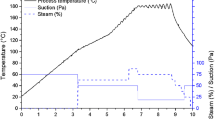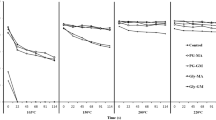Abstract
Thermal modification of wood leads to improved resistance against fungal decay and decreased moisture uptake. Polyoses contribute most to the sorption behaviour of wood and act as main nutrition source for fungi. Thus, especially the conversion of polyoses has major impact on the degree of improvement. Thermal decomposition of wood is accompanied by weight loss. In this work the influence of temperature on weight loss, resulting equilibrium moisture content (EMC) and fungal resistance of OSB-strands is shown. It was found that EMC reaches a constant level, indicating completed reduction of free accessible hydroxyl groups. The levelling was ascertained to be irrespective of the temperature and duration of the pre-treatment. An improved fungal resistance according to durability class 3 and better was found for samples pre-treated above 200 °C. The presented correlation between reduced EMC and improved fungal resistance provides a tool for efficient determination of the durability of thermally modified wood.
Zusammenfassung
Die thermische Modifizierung von Holz resultiert in erhöhter Pilzresistenz und reduzierter Feuchteaufnahme. Die Polyosen sind die sorptiv wirksamste Holzkomponente und gleichzeitig Hauptnahrungsquelle Holz zerstörender Pilze. Daher hat insbesondere die Modifikation der Polyosen entscheidenden Einfluss auf eine Eigenschaftsoptimierung. Die thermische Zersetzung von Holz geht mit einer Masseabnahme einher. In dieser Arbeit wird der Zusammenhang zwischen temperaturabhängiger Masseabnahme, reduzierter Ausgleichsfeuchte und erhöhter Pilzresistenz dargestellt. Die Untersuchung hat gezeigt, dass die Ausgleichsfeuchte ein konstantes Niveau erreicht, welches den Abbau frei zugänglicher Hydroxylgruppen markiert. Das erreichte Niveau bleibt unabhängig von Temperatur und Dauer der Behandlung konstant. Eine erhöhte Pilzresistenz gemäß Dauerhaftigkeitsklasse 3 und besser konnte für Proben, die bei Temperaturen über 200 °C vorbehandelt worden waren, bestimmt werden. Der dargestellte Zusammenhang zwischen reduzierter Ausgleichsfeuchte und verbesserter Pilzresistenz bietet eine praktikable Methode zur schnellen Abschätzung der Dauerhaftigkeit thermisch modifizierten Holzes.
Similar content being viewed by others
References
Bobleter O, Binder H (1980) Dynamischer hydrothermaler Abbau von Holz. Holzforschung 34:48–51
Bourgois J, Guyonnet R (1988) Characterization and analysis of torrefied wood. Wood Sci Technol 22(2):143–155
Burmester A (1970) Formbeständigkeit von Holz gegenüber Feuchtigkeit – Grundlagen und Vergütungsverfahren. BAM Berichte Nr. 4, pp 180
Buro A (1954) Die Wirkung von Hitzebehandlungen auf die Pilzresistenz von Kiefern- und Buchenholz. Holz Roh- Werkst 12:297–304
Byrne CE, Nagle DC (1997) Carbonization of Wood for Advanced Materials Applications. Carbon 35(2):259–266
Chow SZ (1971) Infrared Spectral Characteristics and Surface Inactivation of Wood at High Temperatures. Wood Sci Technol 5:27–39
EN 113 (1996) Wood preservatives – Method of test for determining the protective effectiveness against wood destroying basidiomycetes – Determination of the toxic values
EN 322 (1993) Wood-Based Panels. Determination of Moisture Content
EN 350-1 (1994) Durability of Wood and Wood Based Products – Natural Durability of Solid Wood – Part 1: Guidance to the Principles of Testing and Classification of the Natural Durability of Wood
Fengel D, Wegener G (eds) (1989) Wood-Chemistry, Ultrastructure, Reactions. Walter de Gruyter, Berlin New York
Highley TL (1987) Changes in chemical components of hardwood and softwood by brown-rot fungi. Mater Organismen 22(1):39–45
Jämsä S, Viitaniemi P (2001) Heat Treatment of Wood – Better Durability without Chemicals. Review on Heat Treatments of Wood. Proceedings of Special Seminar in Antibes, France
Kamdem DP, Pizzi A, Triboulot MC (2000) Heat-Treated Timber: Potentially Toxic Byproducts Presence and Extent of Wood Cell Wall Degradation. Holz Roh- Werkst 58:253–257
Kamdem DP, Pizzi A, Jermannaud A (2002) Durability of Heat-Treated Wood. Holz Roh- Werkst 60:1–6
Kennedy RW (1958) Strength retention in wood decayed to small weight losses. For Prod J 8(6):308–314
Klauditz W, Stegmann G (1955) Beiträge zur Kenntnis des Ablaufes und der Wirkung thermischer Reaktionen bei der Bildung von Holzwerkstoffen. Holz Roh- Werkst 13(11):434–440
Kollmann F, Fengel D (1965) Changes in the Chemical Composition of Wood by Thermal Treatment. Holz Roh- Werkst 23:461–468
Leithoff H, Peek R-D (2000) Durability of plywood made from soft- and hardwoods assessed according to ENV 12038 after artificial and natural ageing. The International Research Group on Wood Preservation. Paper prepared for the 31st Annual Meeting, Kona, Hawaii, USA, May 14–19
Mazela B, Zakrzewski R, Grześkowiak W, Cofta G, Bartkowiak M (2004) Resistance of thermally modified wood to basidiomycetes. EJPAU, Wood Technology 7(1)
Miller GL, Blum R (1960) Measurement of Carboxymethyl Cellulase Activity. Anal Biochem 2:127–132
Paul W, Ohlmeyer M (2005) Optimisation of wood based panel properties by heat pre-treatment. Proceedings of the Ninth European Panel Product Symposium, October 5–7 2005, Llandudno, UK
Paul W, Ohlmeyer M, Leithoff H, Boonstra MJ, Pizzi A (2006) Optimising the properties of OSB by a one-step heat pre-treatment process. Holz Roh- Werkst 64:227–234
Runkel R (1951) Zur Kenntnis des thermoplastischen Verhaltens von Holz 1. Mitteilung. Holz Roh- Werkst 9:41–53
Runkel R, Wilke D (1951) Zur Kenntnis des thermoplastischen Verhaltens von Holz, 2. Mitteilung. Holz Roh- Werkst 9:260–270
Sandermann W, Augustin H (1963a) Chemical Investigations on the Thermal Decomposition of Wood, Part I: Stand of Research. Holz Roh- Werkst 21:256–265
Sandermann W, Augustin H (1963b) Chemical Investigations on the Thermal Decomposition of Wood, Part II: Investigations by Means of the Differential Thermal Analysis. Holz Roh- Werkst 21:305–315
Sandermann W, Augustin H (1964) Chemical Investigations on the Thermal Decomposition of Wood, Part III: Chemical Investigation on the Course of Decomposition. Holz Roh- Werkst 22:377–385
Tjeerdsma BF, Boonstra M, Pizzi A, Tekely P, Militz H (1998) Characterisation of Thermally Modified Wood: Molecular Reasons for Wood Performance Improvement. Holz Roh- Werkst 56:149–153
Tjeerdsma BF, Militz H (2005) Chemical Changes in Hydrothermal Treated Wood: FTIR Analysis of Combined Hydrothermal and Dry Heat-Treated Wood. Holz Roh- Werkst 63:102–111
Weiland JJ, Guyonnet R (2003) Study of Chemical Modifications and Fungi Degradation of Thermally Modified Wood Using DRIFT-Spectroscopy. Holz Roh- Werkst 61:216–220
Author information
Authors and Affiliations
Corresponding author
Rights and permissions
About this article
Cite this article
Paul, W., Ohlmeyer, M. & Leithoff, H. Thermal modification of OSB-strands by a one-step heat pre-treatment – Influence of temperature on weight loss, hygroscopicity and improved fungal resistance . Holz Roh Werkst 65, 57–63 (2007). https://doi.org/10.1007/s00107-006-0146-4
Published:
Issue Date:
DOI: https://doi.org/10.1007/s00107-006-0146-4




